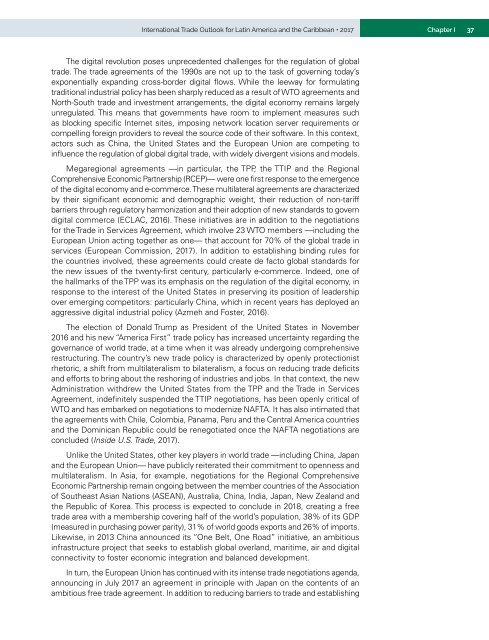International Trade Outlook for Latin America and the Caribbean: Recovery in an uncertain context
This first edition of International Trade Outlook for Latin America and the Caribbean, which is the continuation of Latin America and the Caribbean in the World Economy with a new title, covers 2017 and contains three chapters. The first chapter describes the current international context and the recovery of trade in the region. Chapter II reviews the region’s performance in global trade in services in general and in modern services in particular, since 2005. Chapter III provides an overview of Latin America and the Caribbean’s share of the world agricultural trade since 2000 and offers some policy recommendations for increasing the sector’s contribution to regional development.
This first edition of International Trade Outlook for Latin America and the Caribbean, which is the continuation of Latin America and the Caribbean in the World Economy with a new title, covers 2017 and contains three chapters. The first chapter describes the current international context and the recovery of trade in the region. Chapter II reviews the region’s performance in global trade in services in general and in modern services in particular, since 2005. Chapter III provides an overview of Latin America and the Caribbean’s share of the world agricultural trade since 2000 and offers some policy recommendations for increasing the sector’s contribution to regional development.
Create successful ePaper yourself
Turn your PDF publications into a flip-book with our unique Google optimized e-Paper software.
<strong>International</strong> <strong>Trade</strong> <strong>Outlook</strong> <strong>for</strong> <strong>Lat<strong>in</strong></strong> <strong>America</strong> <strong><strong>an</strong>d</strong> <strong>the</strong> <strong>Caribbe<strong>an</strong></strong> • 2017<br />
Chapter I<br />
37<br />
The digital revolution poses unprecedented challenges <strong>for</strong> <strong>the</strong> regulation of global<br />
trade. The trade agreements of <strong>the</strong> 1990s are not up to <strong>the</strong> task of govern<strong>in</strong>g today’s<br />
exponentially exp<strong><strong>an</strong>d</strong><strong>in</strong>g cross-border digital flows. While <strong>the</strong> leeway <strong>for</strong> <strong>for</strong>mulat<strong>in</strong>g<br />
traditional <strong>in</strong>dustrial policy has been sharply reduced as a result of WTO agreements <strong><strong>an</strong>d</strong><br />
North-South trade <strong><strong>an</strong>d</strong> <strong>in</strong>vestment arr<strong>an</strong>gements, <strong>the</strong> digital economy rema<strong>in</strong>s largely<br />
unregulated. This me<strong>an</strong>s that governments have room to implement measures such<br />
as block<strong>in</strong>g specific Internet sites, impos<strong>in</strong>g network location server requirements or<br />
compell<strong>in</strong>g <strong>for</strong>eign providers to reveal <strong>the</strong> source code of <strong>the</strong>ir software. In this <strong>context</strong>,<br />
actors such as Ch<strong>in</strong>a, <strong>the</strong> United States <strong><strong>an</strong>d</strong> <strong>the</strong> Europe<strong>an</strong> Union are compet<strong>in</strong>g to<br />
<strong>in</strong>fluence <strong>the</strong> regulation of global digital trade, with widely divergent visions <strong><strong>an</strong>d</strong> models.<br />
Megaregional agreements —<strong>in</strong> particular, <strong>the</strong> TPP, <strong>the</strong> TTIP <strong><strong>an</strong>d</strong> <strong>the</strong> Regional<br />
Comprehensive Economic Partnership (RCEP)— were one first response to <strong>the</strong> emergence<br />
of <strong>the</strong> digital economy <strong><strong>an</strong>d</strong> e-commerce. These multilateral agreements are characterized<br />
by <strong>the</strong>ir signific<strong>an</strong>t economic <strong><strong>an</strong>d</strong> demographic weight, <strong>the</strong>ir reduction of non-tariff<br />
barriers through regulatory harmonization <strong><strong>an</strong>d</strong> <strong>the</strong>ir adoption of new st<strong><strong>an</strong>d</strong>ards to govern<br />
digital commerce (ECLAC, 2016). These <strong>in</strong>itiatives are <strong>in</strong> addition to <strong>the</strong> negotiations<br />
<strong>for</strong> <strong>the</strong> <strong>Trade</strong> <strong>in</strong> Services Agreement, which <strong>in</strong>volve 23 WTO members —<strong>in</strong>clud<strong>in</strong>g <strong>the</strong><br />
Europe<strong>an</strong> Union act<strong>in</strong>g toge<strong>the</strong>r as one— that account <strong>for</strong> 70% of <strong>the</strong> global trade <strong>in</strong><br />
services (Europe<strong>an</strong> Commission, 2017). In addition to establish<strong>in</strong>g b<strong>in</strong>d<strong>in</strong>g rules <strong>for</strong><br />
<strong>the</strong> countries <strong>in</strong>volved, <strong>the</strong>se agreements could create de facto global st<strong><strong>an</strong>d</strong>ards <strong>for</strong><br />
<strong>the</strong> new issues of <strong>the</strong> twenty-first century, particularly e-commerce. Indeed, one of<br />
<strong>the</strong> hallmarks of <strong>the</strong> TPP was its emphasis on <strong>the</strong> regulation of <strong>the</strong> digital economy, <strong>in</strong><br />
response to <strong>the</strong> <strong>in</strong>terest of <strong>the</strong> United States <strong>in</strong> preserv<strong>in</strong>g its position of leadership<br />
over emerg<strong>in</strong>g competitors: particularly Ch<strong>in</strong>a, which <strong>in</strong> recent years has deployed <strong>an</strong><br />
aggressive digital <strong>in</strong>dustrial policy (Azmeh <strong><strong>an</strong>d</strong> Foster, 2016).<br />
The election of Donald Trump as President of <strong>the</strong> United States <strong>in</strong> November<br />
2016 <strong><strong>an</strong>d</strong> his new “<strong>America</strong> First” trade policy has <strong>in</strong>creased uncerta<strong>in</strong>ty regard<strong>in</strong>g <strong>the</strong><br />
govern<strong>an</strong>ce of world trade, at a time when it was already undergo<strong>in</strong>g comprehensive<br />
restructur<strong>in</strong>g. The country’s new trade policy is characterized by openly protectionist<br />
rhetoric, a shift from multilateralism to bilateralism, a focus on reduc<strong>in</strong>g trade deficits<br />
<strong><strong>an</strong>d</strong> ef<strong>for</strong>ts to br<strong>in</strong>g about <strong>the</strong> reshor<strong>in</strong>g of <strong>in</strong>dustries <strong><strong>an</strong>d</strong> jobs. In that <strong>context</strong>, <strong>the</strong> new<br />
Adm<strong>in</strong>istration withdrew <strong>the</strong> United States from <strong>the</strong> TPP <strong><strong>an</strong>d</strong> <strong>the</strong> <strong>Trade</strong> <strong>in</strong> Services<br />
Agreement, <strong>in</strong>def<strong>in</strong>itely suspended <strong>the</strong> TTIP negotiations, has been openly critical of<br />
WTO <strong><strong>an</strong>d</strong> has embarked on negotiations to modernize NAFTA. It has also <strong>in</strong>timated that<br />
<strong>the</strong> agreements with Chile, Colombia, P<strong>an</strong>ama, Peru <strong><strong>an</strong>d</strong> <strong>the</strong> Central <strong>America</strong> countries<br />
<strong><strong>an</strong>d</strong> <strong>the</strong> Dom<strong>in</strong>ic<strong>an</strong> Republic could be renegotiated once <strong>the</strong> NAFTA negotiations are<br />
concluded (Inside U.S. <strong>Trade</strong>, 2017).<br />
Unlike <strong>the</strong> United States, o<strong>the</strong>r key players <strong>in</strong> world trade —<strong>in</strong>clud<strong>in</strong>g Ch<strong>in</strong>a, Jap<strong>an</strong><br />
<strong><strong>an</strong>d</strong> <strong>the</strong> Europe<strong>an</strong> Union— have publicly reiterated <strong>the</strong>ir commitment to openness <strong><strong>an</strong>d</strong><br />
multilateralism. In Asia, <strong>for</strong> example, negotiations <strong>for</strong> <strong>the</strong> Regional Comprehensive<br />
Economic Partnership rema<strong>in</strong> ongo<strong>in</strong>g between <strong>the</strong> member countries of <strong>the</strong> Association<br />
of Sou<strong>the</strong>ast Asi<strong>an</strong> Nations (ASEAN), Australia, Ch<strong>in</strong>a, India, Jap<strong>an</strong>, New Zeal<strong><strong>an</strong>d</strong> <strong><strong>an</strong>d</strong><br />
<strong>the</strong> Republic of Korea. This process is expected to conclude <strong>in</strong> 2018, creat<strong>in</strong>g a free<br />
trade area with a membership cover<strong>in</strong>g half of <strong>the</strong> world’s population, 38% of its GDP<br />
(measured <strong>in</strong> purchas<strong>in</strong>g power parity), 31% of world goods exports <strong><strong>an</strong>d</strong> 26% of imports.<br />
Likewise, <strong>in</strong> 2013 Ch<strong>in</strong>a <strong>an</strong>nounced its “One Belt, One Road” <strong>in</strong>itiative, <strong>an</strong> ambitious<br />
<strong>in</strong>frastructure project that seeks to establish global overl<strong><strong>an</strong>d</strong>, maritime, air <strong><strong>an</strong>d</strong> digital<br />
connectivity to foster economic <strong>in</strong>tegration <strong><strong>an</strong>d</strong> bal<strong>an</strong>ced development.<br />
In turn, <strong>the</strong> Europe<strong>an</strong> Union has cont<strong>in</strong>ued with its <strong>in</strong>tense trade negotiations agenda,<br />
<strong>an</strong>nounc<strong>in</strong>g <strong>in</strong> July 2017 <strong>an</strong> agreement <strong>in</strong> pr<strong>in</strong>ciple with Jap<strong>an</strong> on <strong>the</strong> contents of <strong>an</strong><br />
ambitious free trade agreement. In addition to reduc<strong>in</strong>g barriers to trade <strong><strong>an</strong>d</strong> establish<strong>in</strong>g


















